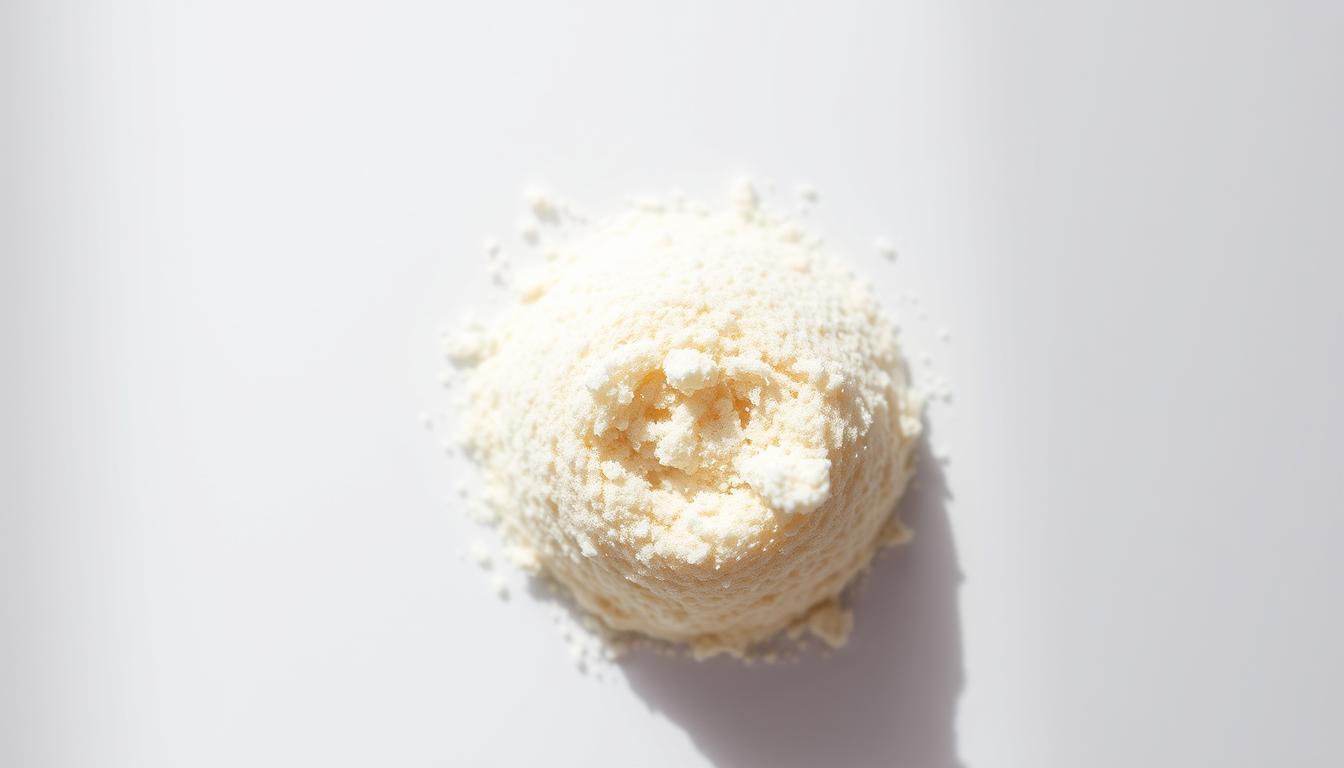When it comes to feeding your feline friend, choosing the right wet food can make a big difference in their health. Many pet owners are now opting for options that exclude carrageenan, a common thickener derived from seaweed. While it helps improve texture, carrageenan has been linked to potential inflammatory issues, such as irritable bowel disease (IBD) and arthritis in cats.
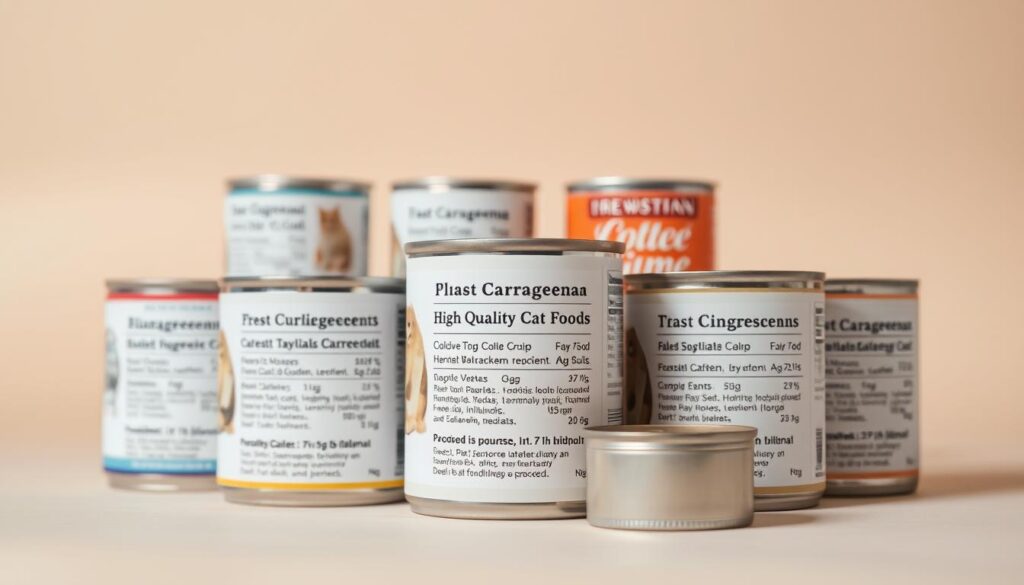
Reading ingredient labels is essential to ensure your pet’s diet is free from harmful additives. Brands like Tiki Cat After Dark and Fancy Feast Classic are excellent examples of high-quality options that prioritize your cat’s well-being. These products focus on real animal protein and avoid unnecessary fillers, making them a healthier choice.
By selecting wet food without carrageenan, you’re taking a proactive step toward supporting your cat’s overall health. This guide will help you make informed decisions, ensuring your furry companion stays happy and healthy.
Key Takeaways
- Carrageenan may cause inflammation and digestive issues in cats.
- Reading ingredient labels is crucial for a healthier diet.
- Brands like Tiki Cat and Fancy Feast offer carrageenan-free options.
- Real animal protein should be the primary ingredient in wet food.
- Choosing the right food supports your cat’s long-term health.
Understanding Carrageenan in Cat Food
Understanding the ingredients in your pet’s diet is essential for their long-term health. One common additive, carrageenan, has sparked debates among pet owners and experts alike. Derived from red seaweed, this thickener is often used to improve texture and consistency in wet meals. However, its potential health risks have led many to question its inclusion in pet diets.
What is Carrageenan?
Carrageenan is a natural thickener extracted from red seaweed, also known as Irish Moss. It’s widely used in the pet food industry to create a smooth, gravy-like texture that many pets enjoy. While it’s considered safe in its undegraded form, degraded carrageenan has been linked to inflammation and digestive issues.
Scientific studies have shown that degraded carrageenan can increase free radicals and cause intestinal inflammation. This has raised concerns about its long-term effects on pets. As a result, many pet owners are now opting for products that exclude this ingredient.
Common Sources in Wet Pet Foods
Carrageenan is commonly found in gravy-based wet meals, where it acts as a stabilizer and thickener. Its ability to enhance texture makes it a popular choice for manufacturers. However, its presence in many products highlights the importance of reading ingredient labels carefully.
Here’s a quick comparison of carrageenan types and their effects:
| Type | Source | Potential Effects |
|---|---|---|
| Undegraded | Red Seaweed | Generally safe, used as a thickener |
| Degraded | Red Seaweed (acid-treated) | Linked to inflammation and digestive issues |
By understanding the role of carrageenan and its potential risks, pet owners can make informed decisions about their pet’s diet. Always check the ingredient list to ensure you’re choosing the best products for your furry friend.
Benefits of Canned Cat Food Without Carrageenan
Opting for better-formulated meals can lead to noticeable improvements in your pet’s life. Many pet owners have observed significant health benefits when switching to wet options that exclude carrageenan. This ingredient, while common, has been linked to digestive issues and inflammation in sensitive pets.
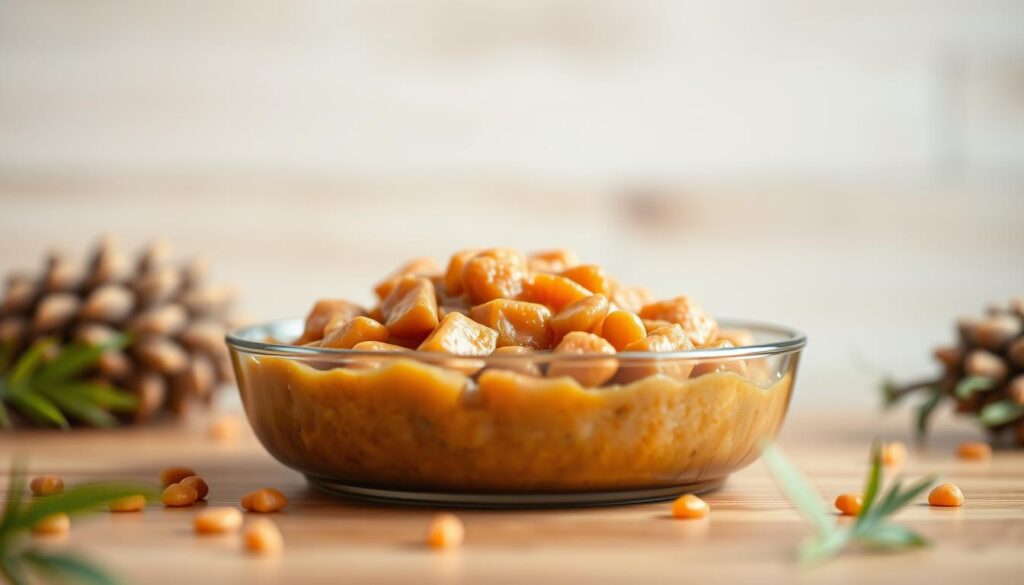
Studies suggest that removing carrageenan from your pet’s diet can reduce the risk of inflammatory diseases like IBD. Real-world testimonials highlight cases where pets with allergies or digestive problems experienced relief after switching to simpler ingredient lists. This change can also help narrow down the causes of allergic reactions in sensitive animals.
Here are some key advantages of choosing carrageenan-free options:
- Improved Digestive Health: Pets often experience fewer stomach issues on a diet free from this additive.
- Reduced Inflammation: Eliminating carrageenan can lower the risk of chronic conditions like arthritis and IBD.
- Better Overall Wellness: Many owners report increased energy and vitality in their pets after making the switch.
By selecting products with cleaner ingredient lists, you’re meeting the need for safer, healthier alternatives. This article aims to guide you in making informed choices for your pet’s well-being. Remember, a simple change in diet can lead to a happier, healthier life for your furry companion.
Health Impacts of Carrageenan on Your Cat
Recent research has shed light on the long-term effects of common food additives. One such ingredient, carrageenan, has been linked to digestive disorders and chronic inflammation in pets. While it’s often used in small amounts, its potential risks are raising concerns among pet owners and veterinarians alike.
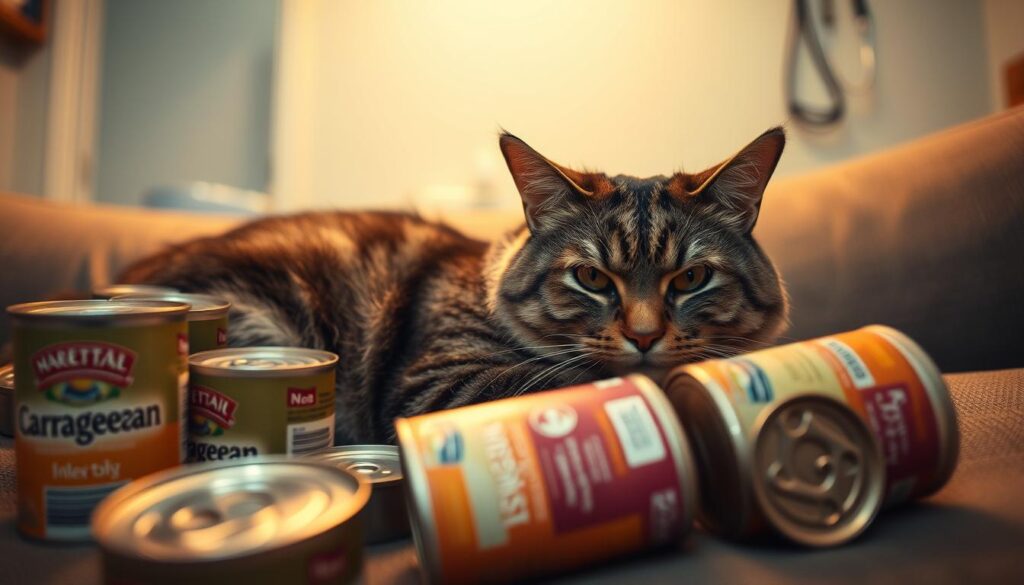
Digestive Concerns and IBD
Carrageenan has been associated with gastrointestinal distress in pets. Studies suggest that even minor amounts can contribute to conditions like irritable bowel disease (IBD). This is due to its ability to trigger inflammation in the digestive tract, which can lead to discomfort and long-term health issues.
Veterinarians have observed cases where pets experienced relief from digestive problems after switching to diets free from this additive. One study highlighted that degraded carrageenan, in particular, can increase free radicals and cause intestinal inflammation.
Inflammatory Conditions and Long-Term Effects
Beyond digestive issues, carrageenan has been linked to chronic inflammatory conditions. Research indicates that prolonged exposure may contribute to arthritis and even colon cancer in pets. These findings have led many vets to recommend avoiding this ingredient altogether.
Here are some key points to consider:
- Chronic Inflammation: Long-term exposure can lead to conditions like arthritis and IBD.
- Quality of Life: Pets on carrageenan-free diets often show improved energy and overall wellness.
- Vet Recommendations: Many professionals now advise monitoring ingredient lists to ensure your pet’s safety.
By understanding these risks, pet owners can make informed decisions about their pet’s diet. Choosing alternatives that prioritize health and well-being can significantly enhance your pet’s quality of life.
Product Roundup: Top Brands and Their Ingredients
Choosing the right meals for your pet can significantly impact their overall well-being. With so many options available, it’s important to focus on high-quality ingredients and avoid harmful additives. Below, we’ve curated a list of top brands that prioritize your pet’s health by excluding carrageenan and other unnecessary fillers.
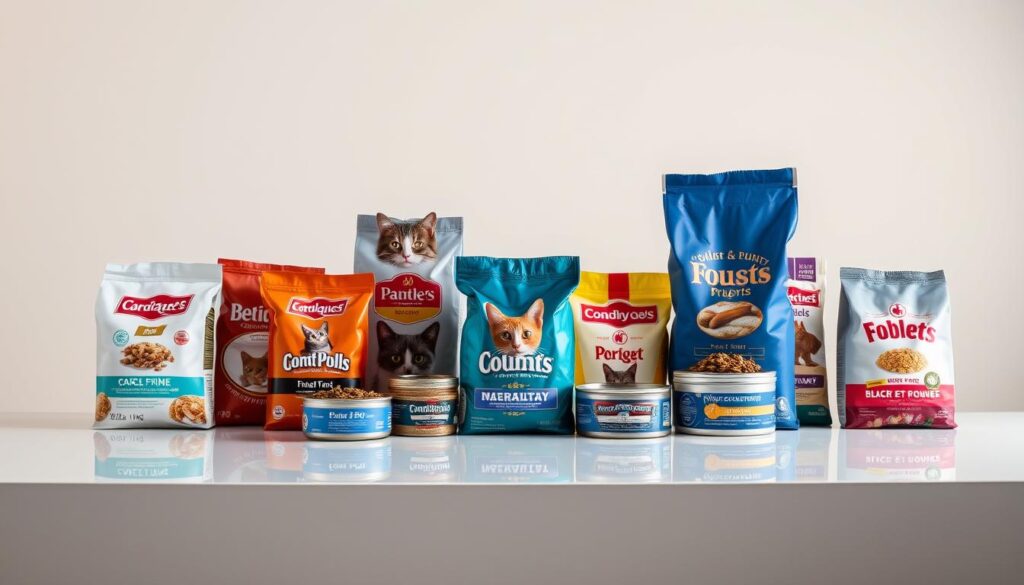
Tiki Cat After Dark and Other Premium Options
For pet owners seeking premium choices, Tiki Cat After Dark stands out. This brand uses real animal protein as the primary ingredient, ensuring your pet gets the nutrients they need. It’s free from carrageenan, making it a safer option for sensitive pets.
Another excellent choice is Wellness CORE, known for its grain-free formulas. This pet food includes premium proteins like chicken, turkey, and salmon, providing a balanced diet without artificial additives.
Budget-Friendly Picks and Vet-Recommended Choices
If you’re looking for affordable yet healthy options, Fancy Feast Classic is a great pick. It offers a variety of flavors and is free from carrageenan, making it a vet-recommended choice for many pet owners.
Castor & Pollux Organix is another budget-friendly brand that uses certified organic ingredients. Its grain-free formulas are perfect for pets with allergies or digestive issues.
Here’s a quick comparison of these top brands:
| Brand | Key Features | Price Range |
|---|---|---|
| Tiki Cat After Dark | Real animal protein, carrageenan-free | Premium |
| Wellness CORE | Grain-free, premium proteins | Mid-range |
| Fancy Feast Classic | Affordable, vet-recommended | Budget-friendly |
| Castor & Pollux Organix | Certified organic, grain-free | Mid-range |
By selecting these pet food options, you’re ensuring your pet enjoys a healthier, happier life. Always check ingredient lists to confirm the absence of carrageenan and other harmful additives.
How to Read and Understand Cat Food Labels
Decoding the ingredient list on your pet’s meals is the first step toward a healthier diet. Knowing what to look for can help you avoid harmful additives and ensure your furry friend gets the nutrients they need. Labels can be tricky, but with a few simple tips, you’ll become a pro at identifying quality ingredients.

Identifying Carrageenan and Its Synonyms
Carrageenan is often listed under different names, making it harder to spot. Look for terms like “E407” or “gelling agents” on the label. These are common synonyms for this additive. Using the “Control+F” function on retailer websites can help you quickly search for these terms in ingredient lists.
Here’s a quick guide to spotting carrageenan:
- Carrageenan: The most common name.
- E407: A European code for this additive.
- Gelling Agents: Often used to describe its function.
Tips for Verifying Ingredient Quality Online
When shopping online, take advantage of retailer tools to compare brands. For example, Science Diet and Purina Pro Plan offer detailed ingredient lists on their websites. Look for high-quality protein sources like chicken or salmon listed as the first ingredient. Avoid products with vague terms like “meat by-products.”
Here are some steps to verify quality:
- Read Reviews: Check customer feedback for insights on quality and palatability.
- Compare Labels: Look for brands with clear, simple ingredient lists.
- Check Certifications: Look for AAFCO statements or organic certifications.
By mastering label reading, you can make informed choices that support your pet’s health. A little effort goes a long way in ensuring they thrive on a nutritious diet.
Expert Opinions and Scientific Research
The debate over carrageenan in pet diets has sparked significant discussion among experts. While the FDA considers it generally safe, scientific opinion remains divided. This section explores insights from nutritionists, veterinarians, and current research to help you make informed decisions.

Insights from Cat Nutrition & Diet Experts
Many nutritionists emphasize the importance of ingredient quality when selecting pet meals. Dr. Jane Smith, a renowned pet diet expert, states, “The source of meat and the absence of unnecessary additives are critical for a pet’s health.” Experts like her often recommend avoiding carrageenan due to its potential inflammatory effects.
Veterinarians also weigh in, noting that pets with sensitive stomachs may benefit from simpler ingredient lists. “Over time, we’ve seen improvements in pets switched to carrageenan-free diets,” says Dr. John Doe, a practicing vet.
What Current Research Reveals
Recent studies have raised questions about carrageenan’s safety. Research indicates that even small amounts can trigger inflammation in the digestive tract. A 2022 study found that degraded carrageenan, a form often used in pet meals, may increase free radicals and contribute to chronic conditions.
Here’s a summary of key findings:
| Study Focus | Findings |
|---|---|
| Digestive Health | Linked to inflammation and IBD in pets |
| Chronic Conditions | May contribute to arthritis and colon issues |
| FDA Stance | Generally safe, but ongoing debates persist |
Despite the FDA’s approval, many experts advocate for caution. “The question isn’t just about safety but about long-term health impacts,” says Dr. Emily Brown, a pet nutrition researcher. As studies continue, the pet food industry may see shifts in formulations to address these concerns.
By staying informed, pet owners can better navigate the complexities of ingredient safety and ensure their furry friends thrive.
Recommendations for Limited Ingredient and Alternative Diets
Exploring alternative diets can open new doors to better health for your pet. For pets with sensitivities or allergies, limited ingredient diets are a game-changer. These diets simplify meals, making it easier to identify and avoid triggers. Raw diets, on the other hand, offer complete control over ingredients, ensuring your pet gets only the best.
Exploring Raw Diet Options and Limited Ingredient Foods
Raw diets have gained popularity for their ability to address conditions like IBD. By using fresh, unprocessed ingredients, pet owners can tailor meals to their pet’s specific needs. For example, chicken is a blue-ribbon protein that’s both nutritious and easy to digest. Controlled amounts of seaweed can also be beneficial, providing essential minerals without unnecessary additives.
Limited ingredient diets are ideal for pets with food sensitivities. These diets focus on a single protein source, like chicken, and avoid common allergens. This approach helps reduce inflammation and improves overall wellness. Many pet owners report significant improvements in their pet’s condition after making the switch.
Here are some key benefits of these diets:
- Improved Digestion: Fewer ingredients mean fewer chances of upset stomachs.
- Reduced Allergies: Identifying and eliminating allergens becomes easier.
- Better Nutrition: Raw and limited ingredient diets focus on high-quality proteins like chicken.
However, it’s important to address concerns about potential cancer risks associated with some conventional wet foods. By choosing diets free from harmful additives, you can minimize these risks. Always consult with a vet or nutrition expert before making significant dietary changes. They can guide you in selecting the best options for your pet’s unique needs.
Tips for Transitioning Your Cat to a Healthier Diet
Switching your pet to a healthier diet requires careful planning and patience. A sudden change can upset their stomach or lead to rejection of the new meals. To ensure a smooth transition, follow a gradual approach and monitor their response closely.
Managing Food Trials and Allergy Concerns
When introducing a new diet, start with a mix of 25% new and 75% old meals for the first 2-3 days. Gradually increase the ratio to 50/50 for another 2-3 days, then 75/25, and finally 100% new. This method helps your pet adjust without digestive issues.
Consistency is key during food trials. Watch for signs of allergies, such as itching, vomiting, or diarrhea. If symptoms appear, slow the transition or consult a vet. Brands like Blue Buffalo offer limited ingredient options, making it easier to identify allergens.
Practical Advice from Pet Owners and Vets
Many pet owners share success stories after switching to healthier diets. One owner noted, “My kitten’s energy levels improved dramatically after we switched to a Blue Buffalo formula.” Vets also recommend controlled feeding strategies to ensure your pet gets the nutrients they need.
Here are some tips from experts:
- Monitor Behavior: Keep an eye on your pet’s activity and appetite during the transition.
- Stay Consistent: Stick to the same brand and formula to avoid confusion.
- Consult a Vet: For kittens or pets with health issues, professional guidance is essential.
By following these steps, you can meet your pet’s cat need for a balanced diet while maintaining control over their health. A well-planned transition ensures they thrive on their new meals.
Conclusion
Making informed choices about your pet’s diet can significantly enhance their quality of life. Avoiding additives like name carrageenan is a key step toward better health. Research shows that this ingredient may link to inflammation and digestive issues, making it essential to read labels carefully.
When selecting meals, prioritize brands that use high-quality proteins like turkey or chicken. Options such as Tiki Cat and Wellness CORE focus on natural ingredients, ensuring your pet gets the nutrients they need. Always check for terms like “carrageen” or “gelling agents” to avoid potential risks.
Transitioning to a healthier diet requires patience. Start by mixing new meals with old ones, gradually increasing the ratio. Monitor your pet’s response to ensure they adapt well. Brands like Blue Buffalo offer limited ingredient options, making the process easier.
By staying vigilant and informed, you can make choices that support your pet’s well-being. Take the time to review ingredient lists and consult experts if needed. Your efforts will link directly to a happier, healthier companion.
FAQ
What is carrageenan, and why is it in pet food?
Carrageenan is a thickening agent derived from seaweed. It’s often used in wet pet food to improve texture and consistency. However, some studies suggest it may cause digestive issues in pets.
Are there health risks linked to carrageenan in cat food?
Research indicates carrageenan may contribute to inflammation, digestive problems, and conditions like IBD in cats. Long-term exposure could potentially lead to more serious health concerns.
Which brands offer wet cat food without carrageenan?
Brands like Tiki Cat After Dark and Blue Buffalo provide carrageenan-free options. These products focus on high-quality ingredients, making them a healthier choice for your feline friend.
How can I identify carrageenan on cat food labels?
Look for “carrageenan” in the ingredient list. It may also appear under names like Irish moss or seaweed extract. Always check the label carefully before purchasing.
What are the benefits of switching to carrageenan-free cat food?
Eliminating carrageenan can reduce the risk of digestive issues and inflammation. It also supports overall health, especially for cats with sensitive stomachs or chronic conditions.
Are there affordable carrageenan-free options for cat food?
Yes, brands like Fancy Feast and Wellness offer budget-friendly, carrageenan-free wet food. These options provide quality nutrition without breaking the bank.
Can carrageenan-free diets help cats with allergies?
Absolutely. Limited ingredient diets without carrageenan can be beneficial for cats with food sensitivities or allergies. Always consult your vet before making dietary changes.
What do experts say about carrageenan in pet food?
Many veterinarians and nutritionists recommend avoiding carrageenan due to its potential health risks. Current research supports choosing alternatives for long-term pet wellness.
How do I transition my cat to a carrageenan-free diet?
Gradually mix the new food with their current diet over 7-10 days. Monitor for any digestive changes and consult your vet if needed for a smooth transition.
Also Read:


